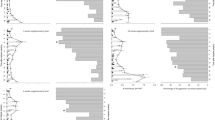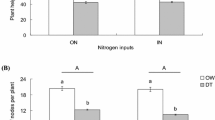Abstract
The objectives of our research were to determine the effect of supplementary food on the dispersion of the predatory bugs Macrolophus pygmaeus (Hemiptera: Miridae), Orius laevigatus and O. majusculus (Hemiptera: Anthocoridae) when released on a pest-infested or non-infested cucumber crop and to evaluate the effectiveness of O. majusculus, released together with the addition of supplemental food, on thrips control. The addition of dry Artemia sp. cysts as supplemental food to the plant where predators were released did not influence their dispersion from the release plant. Predators dispersed to the infested plants despite the provision of supplemental food on the release patch. In addition, in a greenhouse experiment, predator populations increased quicker when supplemental food was provided, resulting in a better thrips control. Altogether, our results suggest that the addition of supplemental food in the patch where predators are released may be beneficial for pest control in greenhouse cucumber crops.


Similar content being viewed by others
References
Arijs Y, De Clercq P (2001) Rearing Orius laevigatus on cysts of the brine shrimp Artemia franciscana. Biol Control 21:79–83
Arnó J, Gabarra R, Tong-Xian L, Alvin MS, Gerling D (2010) Natural enemies of Bemisia tabaci: predators and parasitoids. In: Stansly PA, Naranjo SE (eds) Bemisia: bionomics and management of a global pest. Springer, New York, pp 385–421
Avilla J, Albajes R, Alomar O, Castañé C, Gabarra R (2004) Biological control of whiteflies in vegetable crops. In: Heinz KM, van Driesche RG, Parrella MP (eds) Biocontrol in protected culture. Ball Publishing, Illinois, pp 171–184
Bonte M, De Clercq P (2008) Developmental and reproductive fitness of Orius laevigatus (Hemiptera: Anthocoridae) reared on factitious and artificial diets. J Econ Entomol 101:1127–1133
Castañé C, Riudavets J, Yano E (1999) Biological control of thrips. In: Albajes R, Gullino ML, van Lenteren JC, Elad Y (eds) Integrated pest and disease management in greenhouse crops. Kluwer Academic Publishers, Dordrecht, pp 244–253
Castañé C, Quero R, Riudavets J (2006) The brine shrimp Artemia sp. as alternative prey for rearing the predatory bug Macrolophus caliginosus. Biol Control 38:405–412
Castañé C, Agustí N, Arnó J, Gabarra R, Riudavets J, Comas J, Alomar O (2013) Taxonomic identification of Macrolophus pygmaeus and Macrolophus melanotoma based on morphometry and molecular markers. Bull Entomol Res 103(2):204–215
Chambers RJ, Long S, Helyer NL (1993) Effectiveness of Orius laevigatus (Hem, Anthocoridae) for the control of Frankliniella occidentalis on cucumber and pepper in the UK. Biocontrol Sci Technol 3:295–307
Cocuzza GE, De Clercq P, Lizzio S, van de Veire M, Tirry L, Degheele D, Vacante V (1997) Life tables and predation activity of Orius laevigatus and O. albidipennis at three constant temperatures. Entomol Exp Appl 85:189–198
Dicke M (1994) Local and systemic production of volatile herbivore-induced terpenoids: their role in plant-carnivore mutualism. J Plant Physiol 143:465–472
Dicke M (1999) Evolution of induced indirect defence of plants. In: Tollrian R, Harvell CD (eds) The ecology and evolution of inducible defences. Princeton University Press, Princeton, pp 62–88
Greany PD, Hagen KS (1981) Prey selection. In: Nordlund DA, Jones RL, Lewis WJ (eds) Semiochemicals: their role in pest control. Wiley, New York, pp 121–135
Hulshof J, Ketoja E, Vanninen I (2003) Life history characteristics of Frankliniella occidentalis on cucumber leaves with and without supplemental food. Entomol Exp Appl 108:19–32
Ingegno BL, Pansa MG, Tavella L (2011) Plant preference in the zoophytophagous generalist predator Macrolophus pygmaeus (Heteroptera: Miridae). Biol Control 58:174–181
Janssen A, Bruin J, Jacobs G, Schraag R, Sabelis MW (1997) Predators use volatiles to avoid prey patches with conspecifics. J Anim Ecol 66:223–232
Janssen A, Pallini A, Venzon M, Sabelis MW (1998) Behaviour and indirect interactions in food webs of plant-inhabiting arthropods. Exp App Acarol 22:497–521
Karimy A, Ashouri A, Kharazi Pakdel A, Goldansaz SH, Kosari AA, Moayeri HRS (2006) Olfactory response of the predatory bug, Orius albidipennis to volatile blends of strawberry and cucumber infested by spider mite. Commun Agric Appl Biol Sci 71:399–402
Kim DI, Park JD, Kim SG, Kim SS, Paik CH (2004) Biological control of Thrips palmi (Thysanoptera: Thripidae) with Orius strigicollis (Hemiptera: Anthocoridae) on cucumber in plastic houses in the Southern Region of Korea. J Asia Pac Entomol 7:311–315
Kindt F, Joosten NN, Peters D, Tjallingii WF (2003) Characterisation of the feeding behaviour of western flower thrips in terms of electrical penetration graph (EPG) waveforms. J Insect Physiol 49:183–191
Leman A, Messelink GJ (2015) Supplemental food that supports both predator and pest: a risk for biological control? Exp Appl Acarol 65:511–524
Letourneau DK (1988) Conceptual framework of three-trophic-level interactions. In: Barbosa P, Letourneau DK (eds) Novel aspects of insect-plant interactions. Wiley, New York, pp 1–9
Lins JC Jr, van Loon JJA, Bueno VHP, Lucas-Barbosa D, Dicke M, van Lenteren JC (2014) Response of the zoophytophagous predators Macrolophus pygmaeus and Nesidiocoris tenuis to volatiles of uninfested plants and to plants infested by prey or conspecifics. BioControl 59:707–718
Martinez-Cascales JI, Cenis JL, Cassis G, Sánchez JA (2006) Species identity of Macrolophus melanotoma (Costa 1853) and Macrolophus pygmaeus (Rambur 1839) (Insecta: Heteroptera: Miridae) based on morphological and molecular data and bionomic implications. Insect Syst Evol 37:385–404
Messelink GJ, van Steenpaal SEF, Ramakers PMJ (2006) Evaluation of phytoseiid predators for control of western flower thrips on greenhouse cucumber. BioControl 51:753–768
Messelink GJ, Bennison J, Alomar O, Ingegno BL, Tavella L, Shipp L, Palevsky E, Wäckers FL (2014) Approaches to conserving natural enemy populations in greenhouse crops: current methods and future prospects. BioControl 59:377–393
Moayeri HRS, Ashouri A, Brodsgaard HF, Enkegaard A (2006) Odour-mediated responses of a predatory mirid bug and its prey, the two-spotted spider mite. Exp Appl Acarol 40:27–36
Moayeri HRS, Ashouri A, Poll L, Enkegaard A (2007) Olfactory response of a predatory mirid to herbivore induced plant volatiles: multiple herbivory vs. single herbivory. J Appl Entomol 131:326–332
Montserrat M, Albajes R, Castañé C (2004) Behavioral responses of three plant-inhabiting predators to different prey densities. Biol Control 30:256–264
Oveja MF, Arnó J, Gabarra R (2012) Effect of supplemental food on the fitness of four omnivorous predator species. IOBC/WPRS Bull 80:97–101
Pallini A, Janssen A, Sabelis MW (1997) Odour-mediated responses of phytophagous mites to conspecific and heterospecific competitors. Oecologia 110:179–185
Perdikis D, Lykouressis D (2000) Effects of various items, host plants, and temperatures on the development and survival of Macrolophus pygmaeus Rambur (Hemiptera: Miridae). Biol Control 17:55–60
Perdikis D, Fantinou A, Lykouressis D (2011) Enhancing pest control in annual crops by conservation of predatory Heteroptera. Biol Control 59:13–21
Portillo N, Alomar O, Wäckers FL (2012) Nectarivory by the plant-tissue feeding predator Macrolophus pygmaeus Rambur (Heteroptera: Miridae): Nutritional redundancy or nutritional benefit? J Insect Physiol 58:397–401
Pumariño L, Alomar O (2012) The role of omnivory in the conservation of predators: Orius majusculus (Heteroptera: Anthocoridae) on sweet alyssum. Biol Control 62:24–28
Put K, Bollens T, Wäckers FL, Pekas A (2012) Type and spatial distribution of food supplements impact population development and dispersal of the omnivore predator Macrolophus pygmaeus (Rambur) (Hemiptera: Miridae). Biol Control 63:172–180
Rajabpor A, Seraj AA, Allahyari H, Shishehbor P (2011) Evaluation of Orius laevigatus Fieber (Heteroptera: Anthocoridae) for biological control of Thrips palmi Lindeman (Thysanoptera: Thripidae) on greenhouse cucumber in South of Iran. Asian J Biol Sci 4:457–467
Ramakers PMJ, O’Neill TM (1999) Cucurbits. In: Albajes R, Gullino ML, van Lenteren JC, Elad Y (eds) Integrated pest and disease management in greenhouse crops. Kluwer Academic Publishers, Boston, pp 435–453
Riddick EW (2009) Benefits and limitations of factitious prey and artificial diets on life parameters of predatory beetles, bugs, and lacewings: a mini-review. BioControl 54:325–339
Riudavets J, Castañé C (1998) Identification and evaluation of native predators of Frankliniella occidentalis (Thysanoptera: Thripidae) in the Mediterranean. Environ Entomol 27:86–93
Rodriguez-Saona C, Crafts-Brandner SJ, Williams L III, Paré PW (2002) Lygus hesperus feeding and salivary gland extracts induce volatile emissions in plants. J Chem Ecol 28:1733–1747
Rodriguez-Saona C, Crafts-Brandner SJ, Cañas LA (2003) Volatile emissions triggered by multiple herbivore damage: beet armyworm and whitefly feeding on cotton plants. J Chem Ecol 29:2539–2550
Rosenheim JA, Welter SC, Johnson MW, Mau RFL, Gusukuma-Minuto LR (1990) Direct feeding damage on cucumber by mixed-species infestations of Thrips palmi and Frankliniella occidentalis (Thysanoptera, Thripidae). J Econ Entomol 83:1519–1525
Ruppel RF (1983) Cumulative insect-days as an index of crop protection. J Econ Entomol 76:375–377
Shipp J, Wang K, Binns M (2000) Economic injury levels for western flower thrips (Thysanoptera: Thripidae) on greenhouse cucumber. J Econ Entomol 93:1732–1740
Shipp JL, Ramakers PMJ, Heinz KM (2004) Biological control of thrips on vegetable crops. In: Heinz KM, van Driesche RG, Parella MP (eds) Biocontrol in protected culture. Ball Publishing, Batavia, pp 265–276
Tatemoto S, Shimoda T (2008) Olfactory responses of the predatory mites (Neoseiulus cucumeris) and insects (Orius strigicollis) to two different plant species infested with onion thrips (Thrips tabaci). J Chem Ecol 34:605–613
Tumlinson JH, Turlings TCJ, Lewis WJ (1993) Semiochemically mediated foraging behavior in beneficial parasitic insects. Arch Insect Biochem Physiol 22:385–391
Turlings TC, Tumlinson JH, Lewis WJ (1990) Exploitation of herbivore-induced plant odors by host-seeking parasitic wasps. Science 250:1251–1253
van Lenteren JC, Manzaroli G (1999) Evaluation and use of predators and parasitoids for biological control of pests in greenhouses. In: Albajes R, Gullino ML, van Lenteren JC, Elad Y (eds) Integrated pest and disease management in greenhouse crops. Kluwer Academic Publishers, Dordrecht, pp 183–201
van Rijn PCJ, van Houten YM, Sabelis MW (2002) How plants benefit from providing food to predators even when it is also edible to herbivores. Ecology 83:2664–2679
Vandekerkhove B, De Clercq P (2010) Pollen as an alternative or supplementary food for the mirid predator Macrolophus pygmaeus. Biol Control 53:238–242
Vandekerkhove B, Parmentier L, van Stappen G, Grenier S, Febvay G, Rey M, De Clercq P (2009) Artemia cysts as an alternative food for the predatory bug Macrolophus pygmaeus. J Appl Entomol 133:133–142
Vangansbeke D, Nguyen DT, Audenaert J, Verhoeven R, Gobin B, Tirry L, De Clercq P (2015) Supplemental food for Amblyseius swirskii in the control of thrips: feeding friend or foe? Pest Manag Sci. doi:10.1002/ps.4000
Venzon M, Janssen A, Sabelis MW (1999) Attraction of a generalist predator towards herbivore-infested plants. Entomol Exp Appl 93:305–314
Vet LEM, Dicke M (1992) Ecology of infochemical use by natural enemies in a tritrophic context. Annu Rev Entomol 37:141–172
Walling L (2000) The myriad plant responses to herbivores. J Plant Growth Regul 19:195–216
Welter SC, Rosenheim JA, Johnson MW, Mau RFL, Gusukuma-Minuto LR (1990) Effects of Thrips palmi and western flower thrips (Thysanoptera: Thripidae) on the yield, growth, and carbon allocation pattern in cucumbers. J Econ Entomol 83:2092–2101
Wiedenmann RN, Smith JW (1997) Attributes of natural enemies in ephemeral crop habitats. Biol Control 10:16–22
Acknowledgments
We would like to thank Albert Mussoll, Pilar Hernández, Victor Muñoz and Francisca Oliver for their technical assistance. We also thank two anonymous reviewers and the editors for their valuable comments. This work was funded by the Spanish Ministry of Economy and Competitiveness (MINECO AGL2010-18811 and AGL2013-49164-C2-2-R projects). M.F. Oveja was supported by an FPI Grant from MINECO (BES-2008-007336).
Author information
Authors and Affiliations
Corresponding author
Additional information
Handling Editor: Patrick De Clercq.
Rights and permissions
About this article
Cite this article
Oveja, M.F., Riudavets, J., Arnó, J. et al. Does a supplemental food improve the effectiveness of predatory bugs on cucumber?. BioControl 61, 47–56 (2016). https://doi.org/10.1007/s10526-015-9690-3
Received:
Accepted:
Published:
Issue Date:
DOI: https://doi.org/10.1007/s10526-015-9690-3




